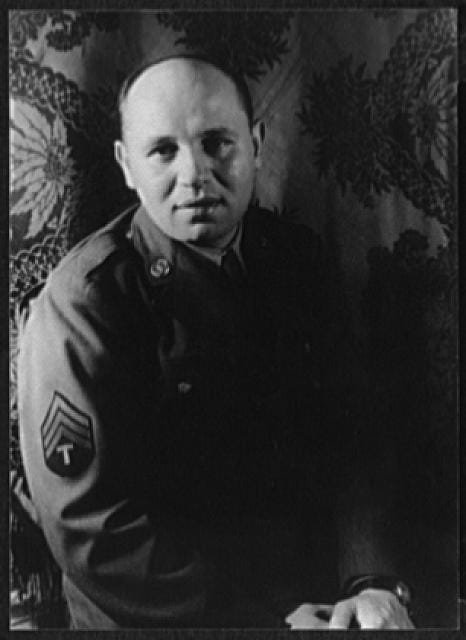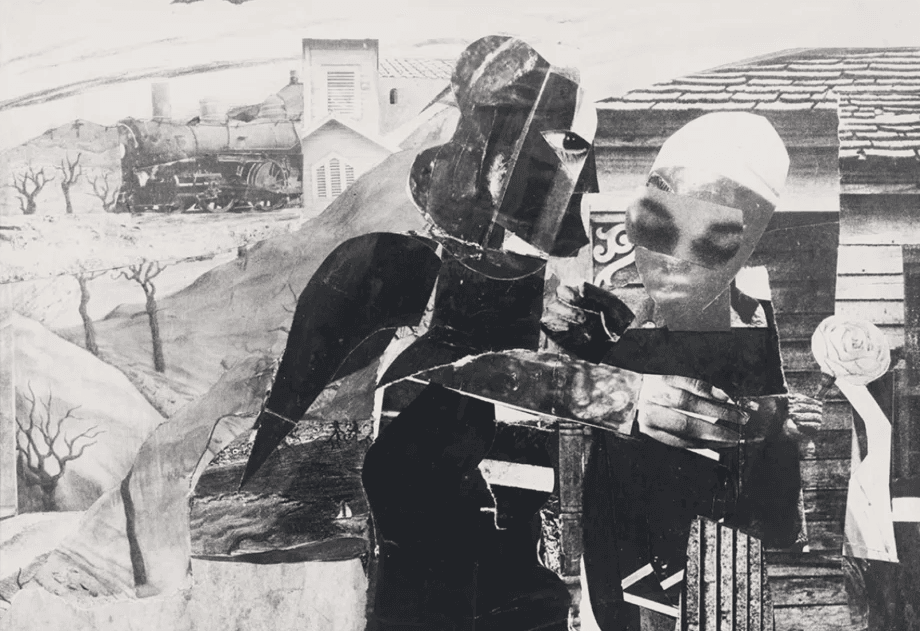Romare Bearden (1911-1988) was a mostly self-taught American artist best known for his collage work. He is considered one of the most important collage artists of the 20th century. Bearden drew inspiration from African art, Cubism, jazz, the Harlem Renaissance and the everyday experiences of Black Americans. Bearden’s collages were innovative, blending African art with European modernism. His work challenged the stereotypes about Black life and provided a multifaceted view of African-American communities.

Romare Bearden’s Early Life
Romare Bearden was born on September 2, 1911 in Charlotte, North Carolina. When Bearden was a toddler, his family moved from the South to New York City as part of the first Great Migration. Romare Bearden grew up in a household where Harlem Renaissance figures like W.E.B. DuBois, Countee Cullen, Langston Hughes and Duke Ellington would visit and gather together. The Lincoln Theatre and the Savoy Ballroom were only a few blocks fom the Bearden home resulting in Romare being immersed in the Blues and jazz music as a child.
Bearden’s father, Howard, was both a pianist and a sanitation inspector. Bearden’s mother, Bessye, was the New York editor for The Chicago Defender, an African-American newspaper. Bessye was also the first president of the Negro Women’s Democratic Association. Romare Bearden remained their only child.
Romare Bearden attended a couple of public schools in New York before moving to Pittsburgh in 1925 to live with his grandparents. His grandmother ran a boarding house that mostly catered to steel mill workers. It was during his time in Pittsburgh that Romare developed an interest in art. Romare’s friend, Eugene Bailey, taught him how to draw. Sadly, Bailey died that same year and Romare Bearden’s initial interest in art began to fade.
In 1929, Romare Bearden graduated from Peabody High School in Pittsburgh, Pennsylvania. Bearden began his college career at Lincloln University, which was the second oldest historically black college in America. This was followed by Romare Bearden transferring to Boston University. While at Boston University, Bearden served as the art director for a college magazine called Beanpot.
Romare also played as a fullback for the school’s football team and pitched for the college baseball team. He even played a bit of semi-professional baseball for the Boston Tigers, a black baseball team. He played against teams in the Negro Leagues and against white baseball teams. While playing for the Pittsburgh Crawfords during a summer break, he even pitched against Satchel Paige. After two summers with the Boston Tigers, an injury gave Bearden second thoughts about baseball.
Romare Bearden’s Path to Professional Artist
In the early 1930s, continued his education at New York University with plans to go to medical school. Bearden had never imagined a career in art, so he majored in science. Bearden studied art, education, science and math while at NYU. During this time, Bearden found that he had began to spend less time on athletics and more time on art. He worked as the lead cartoonist and art editor for The Medley journal. Bearden graduated with a degree in science in 1935.

After college, Bearden met a group of African American artists that later became known as the Harlem Artists Guild. It was then that Bearden decided to become a professional artist. In 1936, Bearden joined the 306 Group which was a group of artists in Harlem (the group was named 306 after the 306 West 141st Street address where they would meet). Bearden became excited about modern art, especially with Cubism, Futurism, Post-Impresssionism and Surrealism. During this same year, Bearden enrolled at the Art Students League where he studied under German artist George Grosz. Grosz introduced Bearden to the works of Goya, Breughel, Daumier, Poussin and Dürer.
Bearden supported himself as a political cartoonist from 1935 to 1937 with a weekly cartoon for the Baltimore Afro-American. Bearden also found work as caseworker for the New York City Department of Social Services. By 1940, Bearden had began to paint using tempera on brown paper. In 1942, Bearden was drafted into the army and served in the all-Black 372nd Infantry Regiment. After being discharged from the army in 1945, Romare held a one man exhibition at the Sameul M. Kootz gallery in Manhattan. He displayed art from his Passion of Christ series. The 24 piece series consisted of Cubist-inspired watercolor and oil paintings depicting the human condition.

From Harlem to Paris
In 1950, Romare Bearden used the G.I. Bill to travel to Paris, France to study at the Sorbonne. Bearden studied philosophy, art history, literature and Buddhism. Bearden also spent a lot of time in museums across France, Italy and Spain. While in Paris, Bearden met painter Georges Braque, sculptor Constatin Brancusi and other artists and writers living in Paris.
When Romare Bearden returned to New York in 1951, he spent some time writing and publishing songs. Bearden co-wrote “Sea Breeze”, which is a jazz classic recorded by Dizzy Gillespie and Billy Eckstine. Bearden also began working as a social worker again. In 1954, Bearden married dancer named Nanette Rohan. She was 27 years his junior. It was his wife and friends that encouraged Bearden to return to painting in the mid-1950s.
The Turn Towards Collage
Bearden experimented with abstract expressionism and produced a series of nonrepresentational paintings. However, Bearden was never satisfied with the results he arrived at with abstract expresssionism. He felt that traditional painting could not fully express the richness and complexity of his subjects. As a result, Bearden began experimenting with painting large areas of color on various thicknesses of rice paper and gluing them to canvas. He would glue several layers of paper on before tearing sections back off again until some type of design appeared . He would then finish up the piece by adding more paper and painting in additional elements.
The 1960s were a pivotal time of Romare Bearden’s career. The Civil Rights Movement, with its struggle for racial equality and social justice, was gaining momentum in the 1960s. In 1963, a group of black artists met in Bearden’s studio to discuss how they could contribute to the civil rights movement. These artists became the group called the “Spiral” and they began to look at how they could use their skills as artists to raise awareness and advocate change in society. One of the Spiral members suggested that Bearden should begin enlarging his work. This suggestion eventually led to the creation of Bearden’s “Projections”.
To make his “photo projections” Romare Bearden would begin by first creating a small collage. He would use bits of photos, magazine clippings and colored paper to arrange his composition. Next, he would take the collages to a Photostat machine (a special kind of photo copier) and enlarge his collages to a large size. The process of making his collages wall-sized with the Photostat machine would also change the images to black and white. This gave them a strong, graphic quality. They were impactful because of their large scale, the social context depicted and the artistic innovation (no one else was blurring the line between photography and collage).

Bearden’s projections were a bold experiment that pushed the boundaries of collage. They were impactful both as art and as social commentary, making them a unique and important part of his legacy. Bearden sought a way to express the struggles and triumphs of Black Americans through his art. He found that collage, with its ability to bring together disparate elements and create layered narratives, offered a powerful new means of expression. Bearden’s art style continued to refine and evolve over his career.
From 1967 to 1969, Romare Bearden made some of his biggest and most interesting artworks. These pieces often showed scenes from his childhood in Mecklenburg County, North Carolina, reminding people of his Southern roots. In the 70s and 80s, Bearden kept making art with the same ideas, focusing on stories and scenes from Black communities and traditions. He also got even better at making his art, finding new ways to use his skills.
Romare Bearden used life-size images and mixed different materials like photos, paint, and colored paper to make his art. Even though he used things like photos and paper, Bearden called these pieces paintings, not collages. He said this because he used these materials in a way that made them look and feel like paintings, with different textures and colors blending together.
Famous Works

Among his most celebrated works is The Prevalence of Ritual: Baptism (1964), a powerful image that blends religious symbolism with scenes of everyday life in the South, highlighting the importance of spiritual traditions in African American communities.

“The Block” (1971) is a monumental collage depicting a bustling street scene in Harlem, capturing the energy and vibrancy of Black urban life.

The “Odysseus Series” (1970s) reimagines Homer’s epic journey through an African American lens, exploring themes of migration, identity, and the search for home.
Romare Bearden’s Lasting Impact
Romare Bearden’s impact on the art world and beyond is immeasurable. He challenged conventional notions of art and paved the way for greater recognition of African American artists. He was the first African American artist to have a solo exhibition at the Museum of Modern Art (MoMA) in New York City, a significant milestone in the fight for inclusivity in the art world.
Towards the end of his life, Bearden received several prestigious awards including honorary doctoral degrees and the President’s National Medal of the Arts from President Ronald Reagan in 1987. In the last years of his life, Bearden and his wife made plans to start a foundation that would aid in the education and training of skilled art students. Romare Bearden died in 1988 from health problems, including bone cancer and a stroke. In 1990, the Romare Bearden Foundation was opened to keep his art and ideas alive.
Romare Bearden’s work served as a bridge between different cultures, connecting African art, European modernism, and the experiences of Black Americans. He helped to expand the definition of American art and to demonstrate the richness and diversity of Black cultural expression with his visual storytelling. Bearden’s innovative approach to collage and his commitment to social and cultural themes continue to inspire artists today.
Partial List of Awards & Honors
| Year | Accomplishment |
| 1972 | Elected to the National Institute of Arts and Letters |
| 1973 | Honorary Doctorate in Fine Arts from the Pratt Institute (Brooklyn, NY). |
| 1975 | Honorary Doctorate of Fine Arts from Carnegie Mellon University (Pittsburgh, PA). |
| 1976 | Gold Medal for Achievements in the Arts by the governor of North Carolina |
| 1978 | Honorary Doctorate in Fine Arts from Davidson (Davidson, NC) |
| 1978 | Freedom Fighter Award from the Atlanta Chapter of the NAACP. |
| 1978 | Awarded the 13th Annual Frederick Douglass Medal from the NY Chapter of the National Urban League. |
| 1980 | Romare Bearden Day declared in Oakland, California. |
| 1987 | President Reagan awards Bearden with the National Medal of the Arts |
| 1988 | Receives posthumous Lifetime Achievement Award from The Studio Museum (Harlem, NY) |
| 2000 | Bearden’s Family (1988) collage is chosen as the national poster for the U.S. Census Bureau’s 2000 census. |
| 2003 | The National Gallery of Art (Washington, D.C.) held a retrospective of Bearden’s work, the first for an African America artist at the institution. |
Article Sources:
- The Romare Bearden Foundation – “Romare Bearden Biography”
- The Smithsonian American Art Museum – “Romare Bearden”
- Biography – “Romare Bearden – Art, Harlem Renaissance & Facts”
- National Gallery of Art – “Romare Bearden”
- Wikipedia – “Romare Bearden”
If you enjoyed this art history article, how about this one on Grant Wood?

Leave a Reply